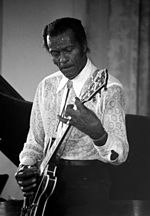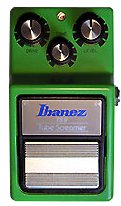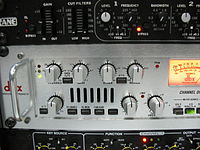Distortion (music)
Distortion and overdrive are forms of
The effects alter the instrument sound by clipping the signal (pushing it past its maximum, which shears off the peaks and troughs of the signal waves), adding sustain and harmonic and inharmonic overtones and leading to a compressed sound that is often described as "warm" and "dirty", depending on the type and intensity of distortion used. The terms distortion and overdrive are often used interchangeably; where a distinction is made, distortion is a more extreme version of the effect than overdrive.[2] Fuzz is a particular form of extreme distortion originally created by guitarists using faulty equipment (such as a misaligned valve (tube); see below), which has been emulated since the 1960s by a number of "fuzzbox" effects pedals.
Distortion, overdrive, and fuzz can be produced by
History

Early uses of amplified distortion
The first guitar amplifiers were relatively low-fidelity, and would often produce distortion when their volume (gain) was increased beyond their design limit or if they sustained minor damage.[5] From 1935 onward, Western swing guitarist Bob Dunn began experimenting with a distorted or "dirty" tone.[6] Later, around 1945, Western swing guitarist and member of the Bob Wills band, Junior Barnard, began experimenting with a rudimentary humbucker pick-up and a small amplifier to obtain his signature "low-down and dirty" bluesy sound which allowed for more "fluid and funky" chords.[6] Many electric blues guitarists, including Chicago bluesmen such as Elmore James and Buddy Guy, experimented in order to get a guitar sound that paralleled the rawness of blues singers such as Muddy Waters and Howlin' Wolf,[7] replacing often their originals with the powerful Valco "Chicagoan" pick-ups, originally created for lap-steel, to obtain a louder and fatter tone. In early rock music, Goree Carter's "Rock Awhile" (1949) featured an over-driven electric guitar style similar to that of Chuck Berry several years later,[8] as well as Joe Hill Louis' "Boogie in the Park" (1950).[9][10]
In the early 1950s, guitar distortion sounds started to evolve based on sounds created earlier in the decade by accidental damage to amps, such as in the popular early recording of the 1951 Ike Turner and the Kings of Rhythm song "Rocket 88", where guitarist Willie Kizart used a vacuum tube amplifier that had a speaker cone slightly damaged in transport.[11][12][13] Electric guitarists began intentionally "doctoring" amplifiers and speakers in order to emulate this form of distortion.[14]
Electric blues guitarist Willie Johnson of Howlin' Wolf′s band began deliberately increasing gain beyond its intended levels to produce "warm" distorted sounds.[5] Guitar Slim also experimented with distorted overtones, which can be heard in his hit electric blues song "The Things That I Used to Do" (1953).[15] Chuck Berry's 1955 classic "Maybellene" features a guitar solo with warm overtones created by his small valve amplifier.[16] Pat Hare produced heavily distorted power chords on his electric guitar for records such as James Cotton's "Cotton Crop Blues" (1954) as well as his own "I'm Gonna Murder My Baby" (1954), creating "a grittier, nastier, more ferocious electric guitar sound,"[17] accomplished by turning the volume knob on his amplifier "all the way to the right until the speaker was screaming."[18]
In 1956, guitarist Paul Burlison of the
In the late 1950s, Guitarist
1960s: fuzz, distortion, and introduction of commercial devices
In 1961,

Shortly thereafter, the American instrumental rock band The Ventures asked their friend, session musician and electronics enthusiast Orville "Red" Rhodes for help recreating the Grady Martin "fuzz" sound.[21] Rhodes offered The Ventures a fuzzbox he had made, which they used to record "2000 Pound Bee" in 1962.[25]
In 1964, a fuzzy and somewhat distorted sound gained widespread popularity after guitarist Dave Davies of The Kinks used a razor blade to slash his speaker cones for the band's single "You Really Got Me".[26]
In May 1965
In 1966, Jim Marshall of the British company Marshall Amplification began modifying the electronic circuitry of his amplifiers so as to achieve a "brighter, louder" sound and fuller distortion capabilities.[32][33] Also in 1966, Syd Barrett of Pink Floyd created the song Interstellar Overdrive, a song made entirely in electric distortion. It was released a year later in modified form on their debut album The Piper at the Gates of Dawn.
In the late 1960s and early 1970s hard rock bands such as Deep Purple, Led Zeppelin and Black Sabbath forged what would eventually become the heavy metal sound through a combined use of high volumes and heavy distortion.[34]
Theory and circuits

The word
Clipping is a
"Soft clipping" gradually flattens the peaks of a signal which creates a number of higher
Distortion and overdrive circuits each 'clip' the signal before it reaches the main amplifier (clean boost circuits do not necessarily create 'clipping') as well as boost signals to levels that cause distortion to occur at the main amplifier's front end stage (by exceeding the ordinary input signal amplitude, thus overdriving the amplifier) Note : product names may not accurately reflect type of circuit involved - see above.[41]
A fuzz box alters an audio signal until it is nearly a square wave and adds complex overtones by way of a frequency multiplier.[42]
Valve overdrive

A basic triode valve (tube) contains a cathode, a plate and a grid. When a positive voltage is applied to the plate, a current of negatively charged electrons flows to it from the heated cathode through the grid. This increases the voltage of the audio signal, amplifying its volume. The grid regulates the extent to which plate voltage is increased. A small negative voltage applied to the grid causes a large decrease in plate voltage.[45]
Valve amplification is more or less linear—meaning the parameters (amplitude, frequency, phase) of the amplified signal are proportional to the input signal—so long as the voltage of the input signal does not exceed the valve's "linear region of operation". The linear region falls between
- The saturation region: the voltages at which plate current stops responding to positive increases in grid voltage and
- The cutoff region: the voltages at which the charge of the grid is too negative for electrons to flow to the plate. If a valve is biased within the linear region and the input signal's voltage exceeds this region, overdrive and non-linear clipping will occur.[43][46]
Multiple stages of valve gain/clipping can be "cascaded" to produce a thicker and more complex distortion sound. In layperson's terms, a musician will plug a fuzz pedal into a tube amp that is being "cranked" to a clipping "overdriven" condition; as such, the musician will get the distortion from the fuzz which is then distorted further by the amp. During the 1990s, some Seattle grunge guitarists chained together as many as four fuzz pedals to create a thick "
In some modern valve effects, the "dirty" or "gritty" tone is actually achieved not by high voltage, but by running the circuit at voltages that are too low for the circuit components, resulting in greater non-linearity and distortion. These designs are referred to as "starved plate" configurations, and result in an "amp death" sound.[citation needed]
Solid-state distortion
Approaches
Guitar distortion can be produced by many components of the guitar's signal path, including effects pedals, the pre-amplifier, power amplifier, and speakers. Many players use a combination of these to obtain their "signature" tone.
Pre-amplifier distortion
The
During the 1980s and 1990s, most valve amps featured a "master volume" control, an adjustable attenuator between the preamp section and the power amp. When the preamp volume is set high to generate high distortion levels, the master volume lowered, keeping the output volume at manageable levels.
Overdrive/distortion pedals


Analog
Most overdrive/distortion pedals can be used in two ways: a pedal can be used as a "boost" with an already overdriven amplifier to drive it further into saturation and "color" the tone, or it can be used with a completely clean amplifier to generate the whole overdrive/distortion effect. With care—and with appropriately chosen pedals—it is possible to "stack" multiple overdrive/distortion pedals together, allowing one pedal to act as a 'boost' for another.[47]
Fuzz boxes and other heavy distortions can produce unwanted dissonances when playing chords. To get around this, guitar players (and keyboard players) using these effects may restrict their playing to single notes and simple "power chords" (root, fifth, and octave). Indeed, with the most extreme fuzz pedals, players may choose to play mostly single notes, because the fuzz can make even single notes sound very thick and heavy. Heavy distortion also tends to limit the player's control of dynamics (loudness and softness)—similar to the limitations imposed on a Hammond organ player (Hammond organ does not produce louder or softer sounds depending on how hard or soft the performer plays the keys; however, the performer can still control the volume with drawbars and the expression pedal). Heavy metal music has evolved around these restrictions, using complex rhythms and timing for expression and excitement. Lighter distortions and overdrives can be used with triadic chords and seventh chords; as well, lighter overdrive allows more control of dynamics.[citation needed]
Power amplifier distortion
Power valves (tubes) can be overdriven in the same way that pre-amplifier valves can, but because these valves are designed to output more power, the distortion and character they add to the guitar's tone is unique. During the 1960s to early 1970s, distortion was primarily created by overdriving the power valves. Because they have become accustomed to this sound [
Because driving the power valves this hard also means maximum volume, which can be difficult to manage in a small recording or rehearsal space, many solutions have emerged that in some way divert some of this power valve output from the speakers, and allow the player to generate power valve distortion without excessive volume. These include built-in or separate power attenuators and power-supply-based power attenuation, such as a VVR, or Variable Voltage Regulator to drop the voltage on the valves' plates, to increase distortion whilst lowering volume. Guitarists such as Eddie Van Halen have been known to use variacs before VVR technology was invented.[specify] Lower-power valve amps (such as a quarter-watt or less)[citation needed], speaker isolation cabinets, and low-efficiency guitar speakers are also used to tame the volume.
Power-valve distortion can also be produced in a dedicated rackmount valve power amp. A modular rackmount setup often involves a rackmount preamp, a rackmount valve power amp, and a rackmount dummy load to attenuate the output to desired volume levels. Some effects pedals internally produce power-valve distortion, including an optional dummy load for use as a power-valve distortion pedal. Such effects units can use a preamp valve such as the 12AX7 in a power-valve circuit configuration (as in the Stephenson's Stage Hog), or use a conventional power valve, such as the EL84 (as in the H&K Crunch Master compact tabletop unit). However, because these are usually placed before the pre-amplifier in the signal chain, they contribute to the overall tone in a different way. Power amplifier distortion may damage speakers.
A Direct Inject signal can capture the power-tube distortion sound without the direct coloration of a guitar speaker and microphone. This DI signal can be blended with a miked guitar speaker, with the DI providing a more present, immediate, bright sound, and the miked guitar speaker providing a colored, remote, darker sound. The DI signal can be obtained from a DI jack on the guitar amp, or from the Line Out jack of a power attenuator.
Output transformer distortion
The output
Power supply "sag"
Early valve amplifiers used unregulated power supplies. This was due to the high cost associated with high-quality
As this effect is more pronounced with higher input signals, the harder "attack" of a note will be compressed more heavily than the lower-voltage "decay", making the latter seem louder and thereby improving
Speaker distortion
Guitar
When the power delivered to a guitar speaker approaches its maximum rated power, the speaker's performance degrades, causing the speaker to "break up", adding further distortion and colouration to the signal. Some speakers are designed to have much clean headroom, while others are designed to break up early to deliver grit and growl.
Amp modeling for distortion emulation

Guitar amp modeling devices and software can reproduce various guitar-specific distortion qualities that are associated with a range of popular "stomp box" pedals and amplifiers. Amp modeling devices typically use digital signal processing to recreate the sound of plugging into analogue pedals and overdriven valve amplifiers. The most sophisticated devices allow the user to customize the simulated results of using different preamp, power-tube, speaker distortion, speaker cabinet, and microphone placement combinations. For example, a guitarist using a small amp modeling pedal could simulate the sound of plugging their electric guitar into a heavy vintage valve amplifier and a stack of 8 X 10" speaker cabinets.
Voicing with equalization
Guitar distortion is obtained and shaped at various points in the signal processing chain, including multiple stages of
Increasing the bass and treble while reducing or eliminating the centre midrange (750 Hz) results in what is popularly known as a "scooped" sound (since the midrange frequencies are "scooped" out). Conversely, decreasing the bass while increasing the midrange and treble creates a punchy, harsher sound. Rolling off all of the treble produces a dark, heavy sound.
Avoiding distortion

While musicians intentionally create or add distortion to electric instrument signals or vocals to create a musical effect, there are some musical styles and musical applications where as little distortion as possible is sought. When
Sound engineers prevent unwanted, unintended distortion and clipping using a number of methods. They may reduce the gain on microphone preamplifiers on the
Though some
See also
- Distortion meter
- Guitar pedalboard
- Tube sound/Valve sound
References
- ^ Turner, David (1 June 2017). "Look at Me!: The Noisy, Blown-Out SoundCloud Revolution Redefining rap". Rolling Stone. Archived from the original on 13 July 2018.
- ^ "Boost, Overdrive, Distortion & Fuzz Pedals - What's the Difference?". inSync. 2018-01-10. Retrieved 2022-02-01.
- ISBN 9780793591404.
- ISBN 978-1-61774-508-9.
- ^ ISBN 9781423416661.
- ^ ISBN 978-0-8018-7862-6. Retrieved 2023-12-23.
- ISBN 978-0-534-64295-2.
- ISBN 0-8223-1265-4.
- ISBN 0822312654.
His first venture, the Phillips label, issued only one known release, and it was one of the loudest, most overdriven, and distorted guitar stomps ever recorded, "Boogie in the Park" by Memphis one-man-band Joe Hill Louis, who cranked his guitar while sitting and banging at a rudimentary drum kit.
- ISBN 0394513223. Retrieved 5 July 2012.
Black country bluesmen made raw, heavily amplified boogie records of their own, especially in Memphis, where guitarists like Joe Hill Louis, Willie Johnson (with the early Howlin' Wolf band) and Pat Hare (with Little Junior Parker) played driving rhythms and scorching, distorted solos that might be counted the distant ancestors of heavy metal.
- ISBN 9780826463227.
- ^ "How Sam Phillips Invented the Sound of Rock and Roll". popularmechanics.com. 15 August 2016. Retrieved 29 April 2017.
- ^ Halberstadt, Alex (29 October 2001). "Sam Phillips, the Sun king". salon.com. Retrieved 29 April 2017.
- ^ Denise, Sullivan. "You Really Got Me". Allmusic. Retrieved 2008-05-24.
- ISBN 978-1589806771.
- ISBN 9781854108739.
- ISBN 0-8223-1265-4.
- Allmusic. Retrieved January 25, 2010.
- ^ Dahl, Bill. "The Train Kept A-Rollin'". Allmusic. Retrieved 2008-05-24.
- ISBN 0-252-06915-3.
- ^ a b "How Grady Martin Discovered the First Fuzz Effect". Archived from the original on 2010-11-29. Retrieved 2009-04-09.
- ISBN 0-252-06915-3.
While most of the documentation on early fuzz boxes has been discarded or lost, the earliest such devices appear to have been introduced in 1962. The best known from that year was the Maestro Fuzztone FZ-1...
- ^ Dregni, Michael (December 2013). "Maesto Fuzz-Tone". Vintage Guitar. PO Box 7301 Bismarck, ND 58507: Vintage Guitar, Inc. Retrieved November 30, 2015.
{{cite web}}: CS1 maint: location (link) - ISBN 0-252-06915-3.
While most of the documentation on early fuzz boxes has been discarded or lost, the earliest such devices appear to have been introduced in 1962. The best known from that year was the Maestro Fuzztone FZ-1...
- ISBN 978-0-557-04051-3.
- ^ Walser 1993, p. 9
- ^ Bosso, Joe (2006). "No Stone Unturned". Guitar Legends: The Rolling Stones. Future plc. p. 12.
- ^ "Sold on Song: (I Can't Get No) Satisfaction". BBC. Retrieved 2008-03-09.
- ISBN 9780312130626.
- ISBN 9781617747021.
- ISBN 0-87930-731-5.
- ISBN 9780801878626.
- ISBN 0-7935-2509-8.
- ISBN 0-8195-6260-2.
- ISBN 9780295984988.
- ISBN 0-88188-900-8.
- ISBN 9780240520322.
- ISBN 0-88188-900-8.
- ISBN 9780240520865.
- ^ ISBN 9781441995360.
- ISBN 9781441995360.
- ISBN 0-415-97324-4.
- ^ ISBN 0-933224-80-X.
- ^ Blencowe, Merlin. "Understanding the Common-Cathode, Triode Gain Stage" (PDF). Archived from the original (PDF) on 2013-12-28. Retrieved 2008-05-24.
- ISBN 0-933224-96-6.
- ISBN 0-933224-96-6.
- ^ "A Beginner's Guide to Stacking Drive Pedals | Reverb". reverb.com. 16 June 2016. Retrieved 2016-07-18.
- ^ transformer design.
- ^ Aiken, Randall. "What is "sag"?". Archived from the original on 2008-06-23. Retrieved 2008-06-25.
- ^ "Choosing Guitar-amp Speakers | Sound On Sound". www.soundonsound.com. Retrieved 2016-07-18.
External links
- A Musical Distortion Primer (R.G. Keen) Article on the physics of distortion and electronic techniques
- Distortion 101 (Jon Blackstone) Article on the physics of distortion, with interactive demonstrations
- Amptone.com An archived version of a website on overdriven guitar amplifier and effects, covering: tone settings, distortion voicing, simulation and modeling, processors, speakers, power-supply modifications, switching and signal routing gear, software and recording, and DIY projects.
- AX84 Cooperative, non-profit website offering free schematics and plans for building guitar amps.
- Fuzz Central Many schematics and DIY fuzz pedal projects
- Tons of Tones Archived 2011-08-31 at the Wayback Machine Technical website with information on multiFX pedals
